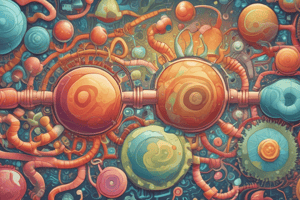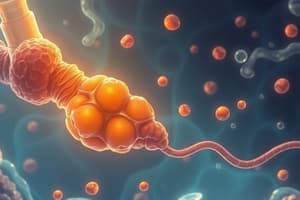Podcast
Questions and Answers
What is the general formula for carbohydrates?
What is the general formula for carbohydrates?
- CnH2nOn (correct)
- CnHnOn
- CnH2nO
- CnHnO
What type of derivatives can carbohydrates be?
What type of derivatives can carbohydrates be?
- Aldehyde and ketone (correct)
- Ester and ether
- Ketone and ether
- Aldehyde and ester
What is one of the important functions of carbohydrates in the body?
What is one of the important functions of carbohydrates in the body?
- Preventing blood clots (correct)
- Maintaining blood pressure
- Regulating body temperature
- Producing hormones
What is the name of the pathway where glucose is converted into energy?
What is the name of the pathway where glucose is converted into energy?
What are ABO blood markers made up of?
What are ABO blood markers made up of?
What is the name of the process by which glucose is absorbed into the bloodstream?
What is the name of the process by which glucose is absorbed into the bloodstream?
What is the primary function of pancreatic bicarbonate in the small intestine?
What is the primary function of pancreatic bicarbonate in the small intestine?
What type of glucose transporters are responsible for glucose absorption in the kidney?
What type of glucose transporters are responsible for glucose absorption in the kidney?
What is the product of glycolysis in the absence of oxygen?
What is the product of glycolysis in the absence of oxygen?
Where does glycolysis occur in the cell?
Where does glycolysis occur in the cell?
What is the consequence of SGLT 1 deficiency in the small intestine?
What is the consequence of SGLT 1 deficiency in the small intestine?
What is the primary function of glucose transport proteins in the small intestine?
What is the primary function of glucose transport proteins in the small intestine?
What is the primary characteristic that distinguishes monosaccharides from other types of carbohydrates?
What is the primary characteristic that distinguishes monosaccharides from other types of carbohydrates?
What is the result of the spontaneous reaction between the aldehyde or ketone group and the alcohol groups on the downstream carbon in an aqueous solution of monosaccharides?
What is the result of the spontaneous reaction between the aldehyde or ketone group and the alcohol groups on the downstream carbon in an aqueous solution of monosaccharides?
What is the minimum number of carbon atoms required for a monosaccharide to be classified as a triose?
What is the minimum number of carbon atoms required for a monosaccharide to be classified as a triose?
Which of the following types of carbohydrates is composed of more than 10 monosaccharide units per molecule?
Which of the following types of carbohydrates is composed of more than 10 monosaccharide units per molecule?
What is the term used to describe a carbon atom that has four different atoms or groups of atoms bonded to it?
What is the term used to describe a carbon atom that has four different atoms or groups of atoms bonded to it?
Which of the following monosaccharides is an exception to the rule that all monosaccharides contain at least one asymmetrical carbon atom?
Which of the following monosaccharides is an exception to the rule that all monosaccharides contain at least one asymmetrical carbon atom?
Flashcards are hidden until you start studying
Study Notes
Classification of Carbohydrates
- Carbohydrates can be classified into three types based on the number of sugar units:
- Monosaccharides: simplest form of sugars, which cannot be further hydrolyzed
- Disaccharides: consist of two monosaccharide units joined together by glycosidic linkage
- Oligosaccharides: 2-10 monosaccharide units linked together
- Polysaccharides: higher polymers of carbohydrates, containing > 10 monosaccharide units per molecule
Monosaccharides
- Monosaccharides contain the elements carbon, hydrogen, and oxygen, and have the general formula Cn(H2O)n, where n ≥ 3
- Monosaccharides cannot be broken down (non-hydrolysable) to smaller carbohydrates
- Classification of monosaccharides is based on:
- Number of carbon atoms: trioses to heptoses
- Functional groups: aldehyde (-CHO) or ketose group (-C=O)
- Cyclic structure of monosaccharides:
- In aqueous solution, the aldehyde or ketone group spontaneously reacts with alcohol groups on the downstream carbon to form ring structures
- New chiral carbon or anomeric center is formed
- Chirality:
- A carbon atom that has four different atoms or groups of atoms bonded to it is called a chiral carbon atom or chiral center
- All monosaccharides contain at least one asymmetrical (chiral) carbon atom and are therefore optically active, except dihydroxyacetone
Importance of Carbohydrates
- Carbohydrates are the major source of energy
- Precursors for many organic compounds (fats, amino acids)
- Constitute an important part of free nucleotides
- Prevent blood clots
- Carbohydrate polymers lubricate skeletal joints
- Carbohydrates are found on the surface of cells, participate in recognition and adhesion between cells
- ABO blood markers found on red blood cells are made up of carbohydrates
Digestion, Absorption, and Transport of Carbohydrates
- Carbohydrate digestion in the small intestine:
- Food bolus enters into the duodenum, exposed to pancreatic juice, containing pancreatic bicarbonate and pancreatic amylase
- Absorption of carbohydrates:
- Monosaccharides are almost completely absorbed from the small intestine
- Two types of glucose transport: Na+-dependent glucose transporters and facilitative glucose transporters
- Two mechanisms of glucose absorption: active absorption and facilitated absorption
Glucose Transport Proteins
- Glucose enters absorptive cells by binding to transport proteins that bind glucose on one side and release it on the opposite side
- Two types of glucose transport proteins:
- Na+-dependent glucose transporters (SGLT 1 and SGLT 2)
- Facilitative glucose transporters
Glycolysis
- Glycolysis is a cascade of reactions that converts glucose into:
- Two pyruvate molecules
- Two lactate molecules (mitochondria/O2 not available)
- Glycolysis can run independent of mitochondria/O2, it is mainly called anaerobic oxidation of glucose
- Intracellular site and tissue distribution: Glycolysis occurs in the cell cytoplasm of all tissues of the body
Studying That Suits You
Use AI to generate personalized quizzes and flashcards to suit your learning preferences.




